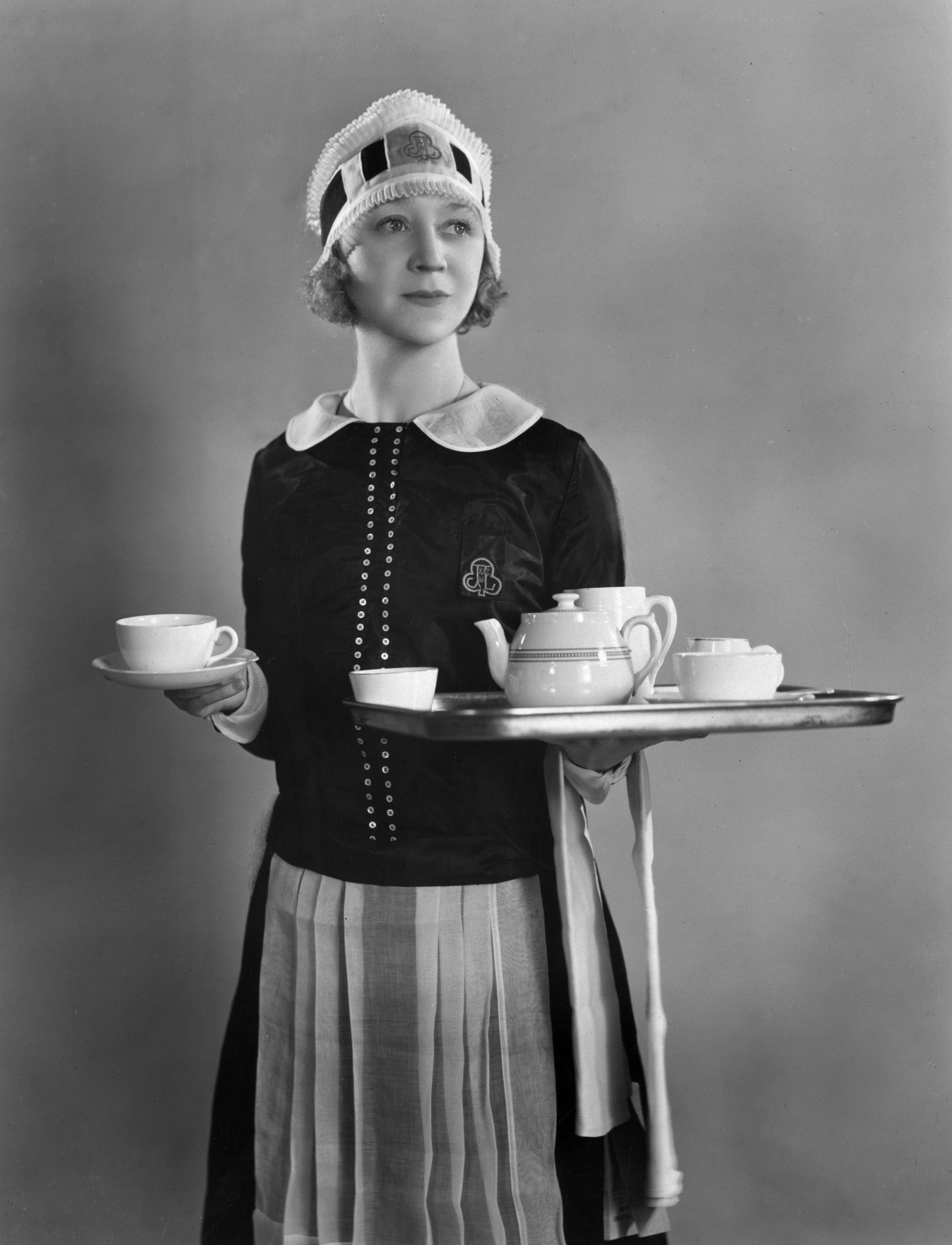
30th August 1930: British revue comedienne Binnie Hale (1899 – 1984), formerly Beatrice Mary Hale-Monro dressed as a waitress for her part in the Julian Wylie production ‘Nippy’, showing at the Prince Edward Theatre in London. (Photo by Sasha/Getty Images)
In 1924 the directors of J. Lyons and Co. decided to update their image and specifically their waitresses. They held a staff competition to choose a nickname for the newly styled Lyon’s teashops’ waitresses. The former name of ‘Gladys’ was now seen as very old fashioned. The name ‘Nippy’ was eventually chosen, probably for the connotation that the waitresses nipped speedily around. If ‘Nippy’ sounds odd as a nickname for a waitress, it’s worth noting that other rejected suggestions included ‘Sybil-at-your-service’, ‘Miss Nimble’, Miss Natty’, ‘Busy Bertha’, ’Speedwell and even ‘Dextrous Dora’.
The Nippies’ dresses were also to be modernised and they also removed the ban on bobbed hair. The (mostly) young women would wear starched caps with a big, red ‘L’ embroidered in the centre, a black Alpaca dress with a double row of pearl buttons sewn with red cotton and white detachable cuffs and collar finished off with a white square apron worn at dropped-waist level.
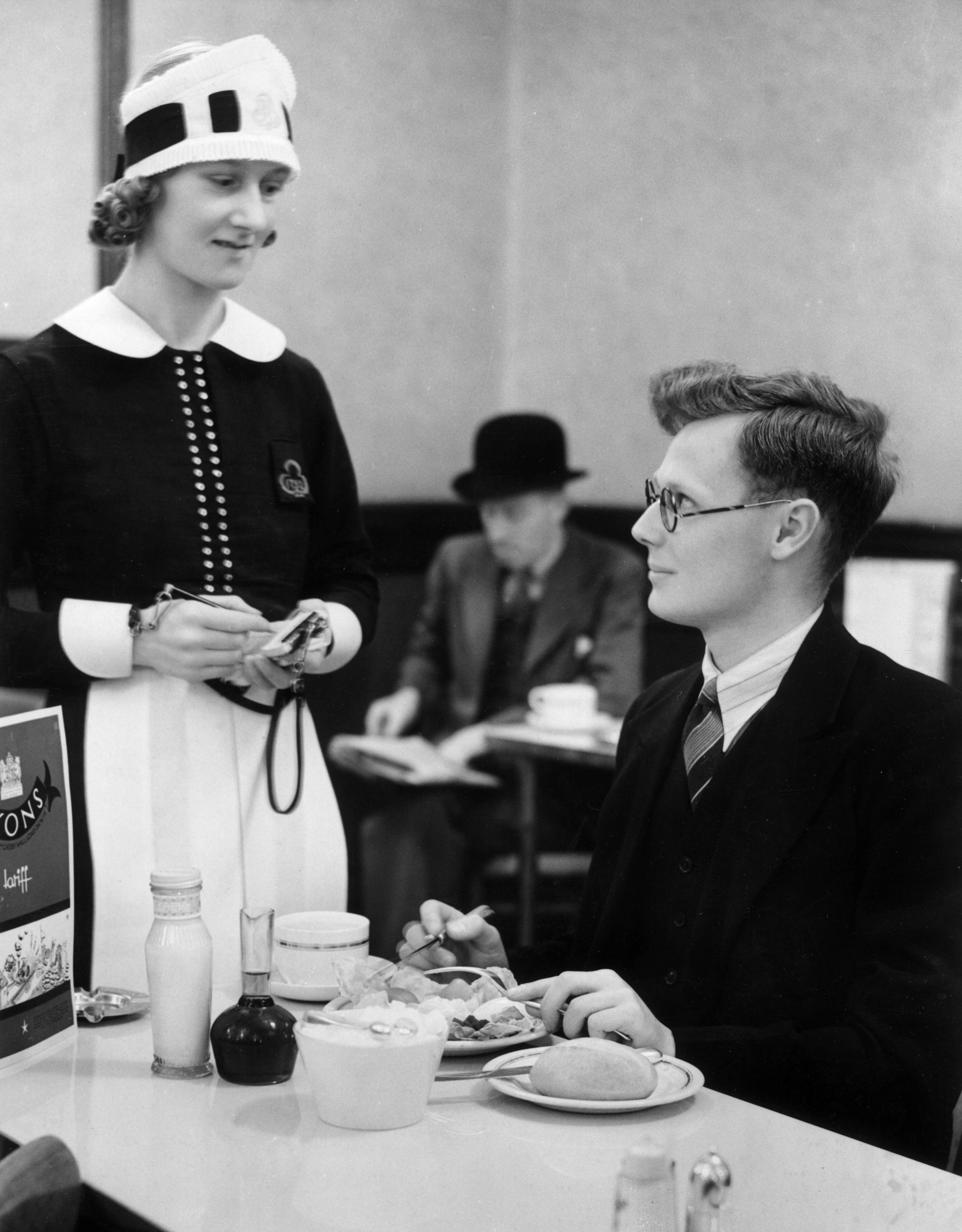
14th July 1939: Mr Edwin Barrall, an office worker in the City of London enjoys his last ‘civvy’ lunch at the Lyon’s Tea Room in Ludgate Circus. The next day he is to become a militiaman at the Army’s headquarters in Aldershot. (Photo by William Vanderson/Fox Photos/Getty Images)
The ‘Nippy’ made her first appearance on New Year’s Day in 1925 and the word soon became a household name. By 1939 there were around 7,600 of them working around the country, all selected on deportment, condition of hands, an ability to add and the competence to handle crockery deftly. A pleasant personality was judged more important at Lyons than good looks and it seems there were a lot of men looking out for a pleasant personality. Picture Post in 1939 reported that there were a total of between 800 and 900 Nippy marriages every year. Lyons claimed that the marriage rate among Nippies was higher than any other class of working girl and that the job was of course excellent training for a housewife.
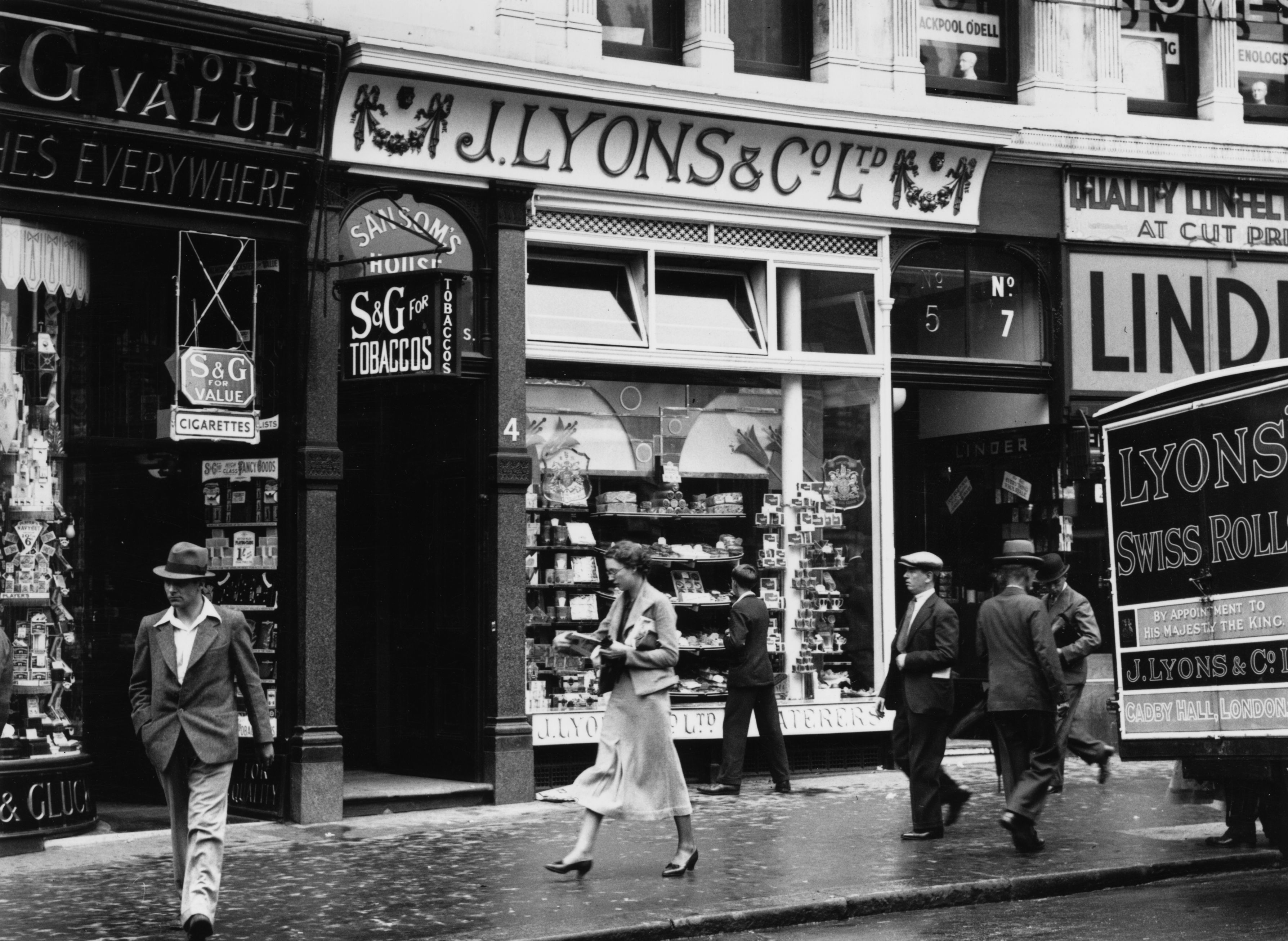
circa 1930: A J Lyon’s & Company cafe in England. (Photo by General Photographic Agency/Getty Images)
J. Lyons and Co. Was established in 1885 by four entrepreneurs Isidore and Montague Glickstein, Barnett Salmon and Joseph Lyons. From modest beginnings as supplier of catering to the Newcastle Exhibition in 1887 it went on the become at its height the largest food company in Europe. The first of the Lyon’s teashops opened at 213 Piccadilly in 1894 (it’s still a cafe, now called Ponti’s and you can still see the original stucco ceiling of the original Lyons teashop). Soon there were more than 250 white and gold fronted teashops occupying prestigious locations on many of London’s high streets. Food and drink prices were the same in each teashop irrespective of locality and the tea was always the best available – although the Lyons blend was never sold or made available to the public.

1907: Sir Joseph Lyons (1848 – 1917) who invented a type of stereoscope. He also established J Lyons and Co which started as a teashop and became one of the largest catering businesses in Britain. (Photo by Topical Press Agency/Getty Images)
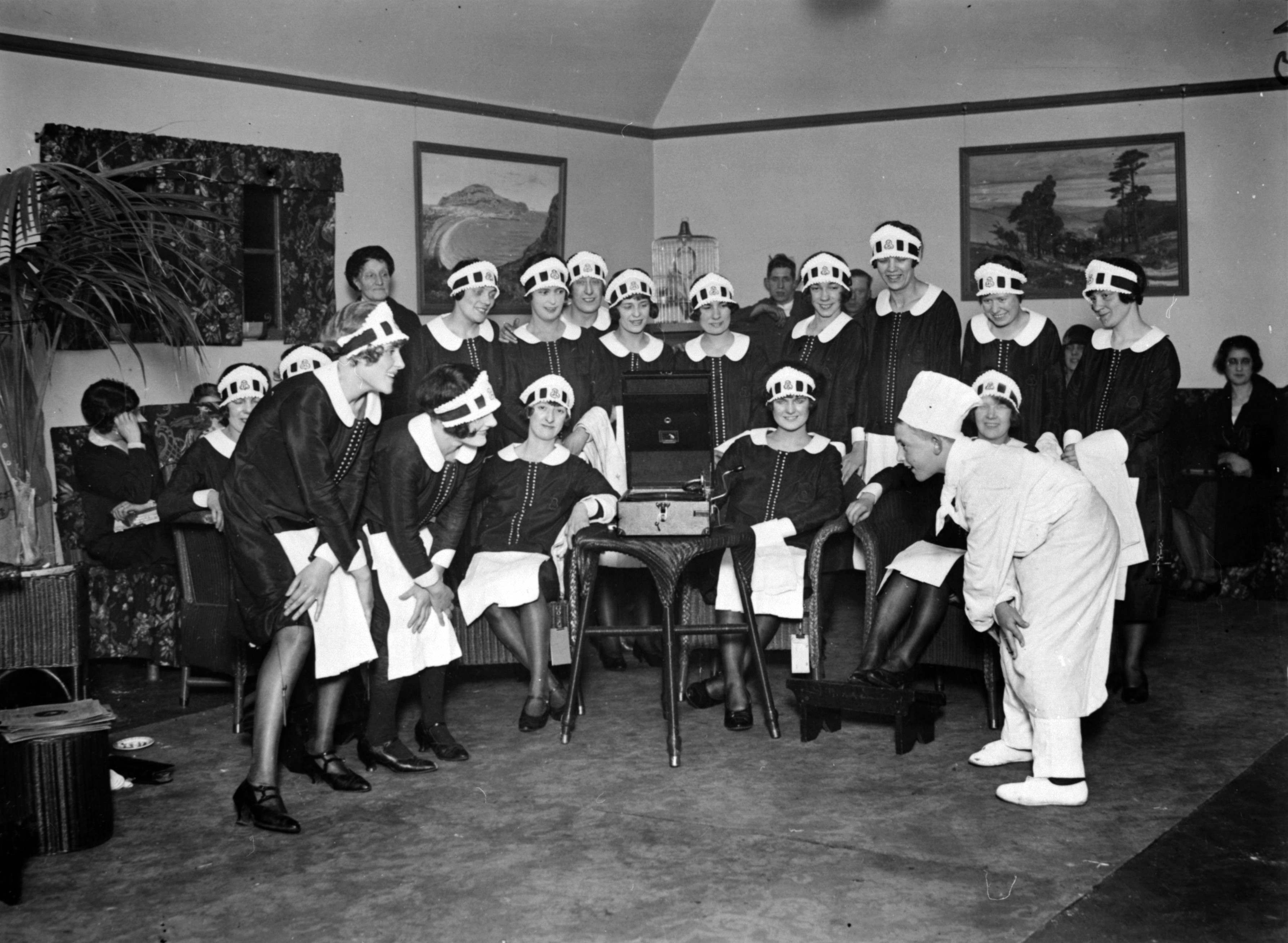
A junior chef explaining the ‘Black Bottom’ dance steps to the waitresses, called nippies, in the rest room of the Lyon’s Corner House. (Photo by Topical Press Agency/Getty Images)
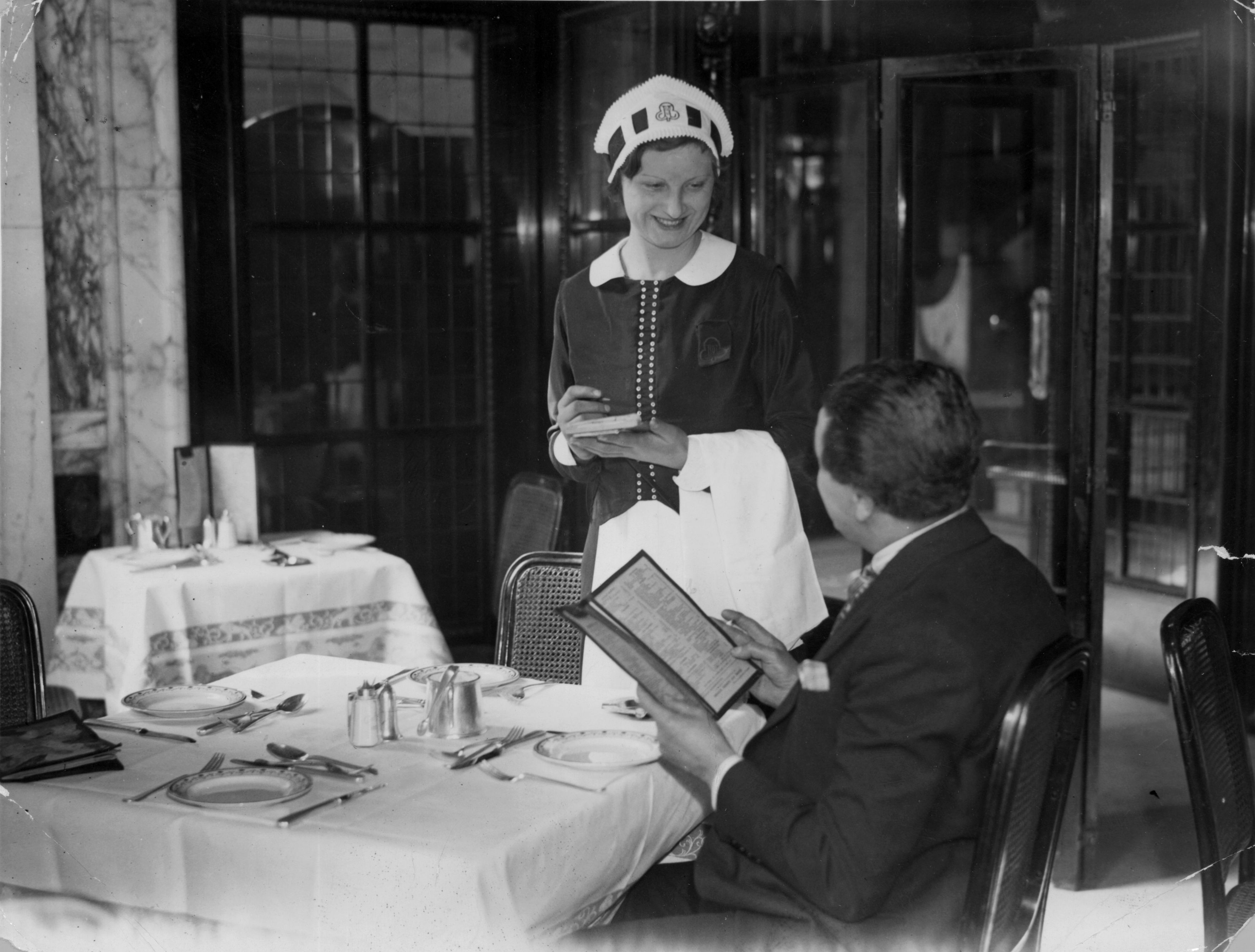
5th April 1935: Miss B Lillywhite, a ‘nippy’ at Coventry Street Corner House in Piccadilly is ready to take an order from a customer. (Photo by Miller/Topical Press Agency/Getty Images)
The J. Lyons flagship shops were the London Corner Houses situated on or near the corners of Coventry Street, the Strand and Tottenham Court Road. They were started in 1909 and remained until 1977. They were gigantic places with food being served on four or five floors. In its heyday the Coventry Street Corner House served about 5000 covers and employed about 400 staff. There were hairdressing salons, telephone booths and even at one point a food delivery service. For a time the Coventry Street Corner House was open 24 hours a day.

circa 1930: Lyon’s Corner House on junction of Coventry Street and Rupert Street in Piccadilly, London W1. (Photo by Sasha/Keystone/Getty Images)
First established in the last quarter of the nineteenth century by four entrepreneurs (Isidore and Montague Gluckstein, Barnett Salmon and Joseph Lyons), J. Lyons & Co. became one of the largest catering and food manufacturing companies in the world. From modest beginnings as supplier of catering to the Newcastle Exhibition (UK), in 1887, the new firm rapidly expanded to become the first food empire which, at its height, was the largest in Europe. In the process Lyons became a household name and the ‘Joe Lyons’ Corner Houses and teashops, with their ‘Nippy’ waitresses, caught the public imagination and passed into history.
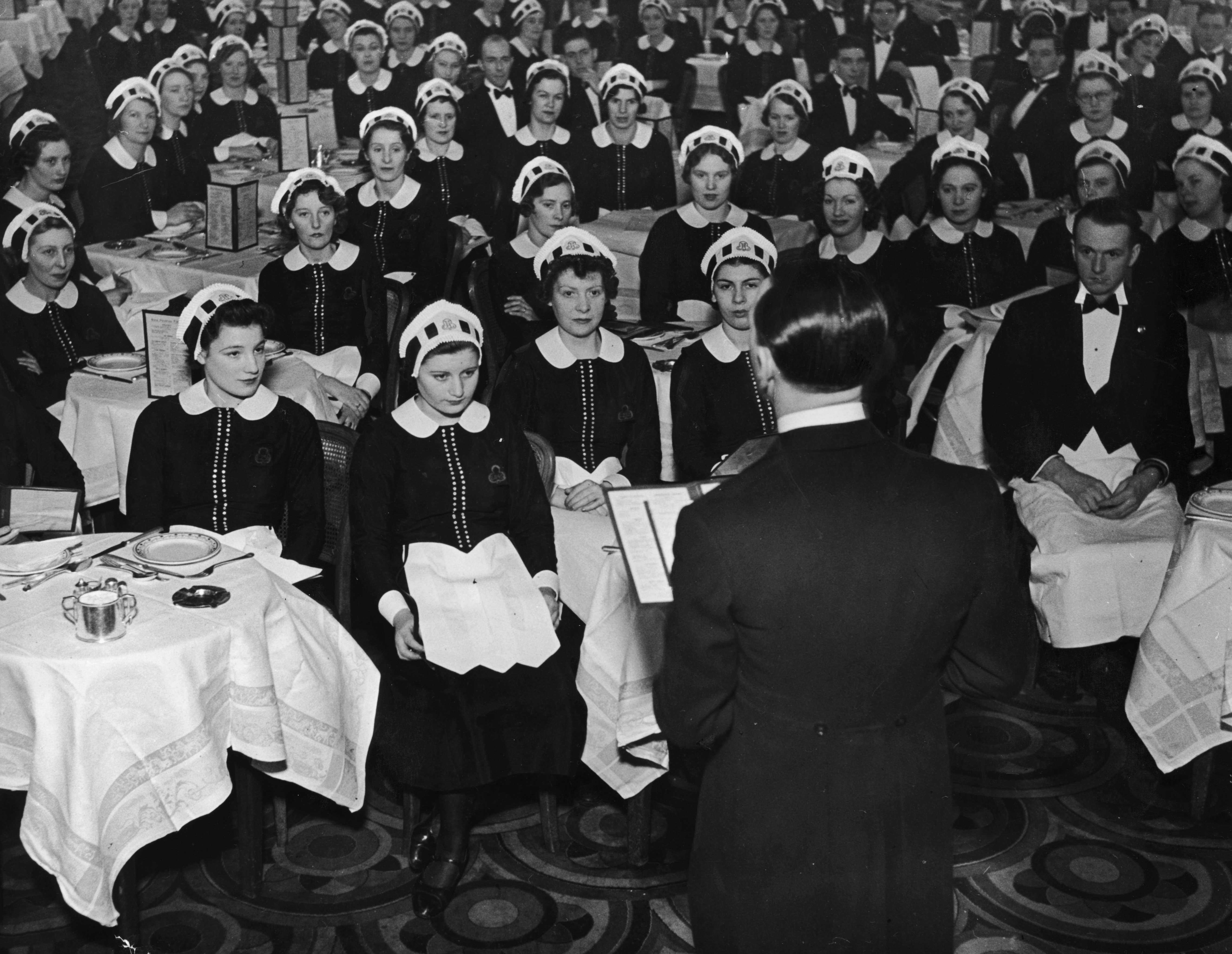
4th March 1939: Waitresses, known as Nippies, at Lyon’s Corner House in London receiving their instructions at the start of the day. (Photo by Bill Brandt/Picture Post/Getty Images)
Soon the company was operating hotels, laundries, tea estates in Nyasaland (now Malawi), meat pie companies, ice-cream companies, tea and coffee companies, engineering works, jam and soft drink factories, confectionery manufacturing and Lyons was the first company to to introduce frozen food to the British public. During the war they managed one of the largest bomb-making facilities in the UK and their engineering works made a range of war materiel. They packed millions of rations for troops fighting in Asia and other parts of the world and bequeathed one of their teashops to the American personnel stationed at Grosvenor Square. Another formed part of the famous Rainbow Corner in Shaftsbury Avenue, near Piccadilly Circus.
After the war the company embarked on a rebuilding programme expanding their operations into Europe and America as well as large projects at home. They acquired the Baskin-Robbins Ice-Cream company and the Dunkin Donuts organisation. They developed the Wimpy hamburger chain which essentially was an American idea. They also built and operated the world’s first business computer which they called LEO (Lyons Electronic Office). Large new bakeries and meat pie factories were built with the aid of regional grants. Several smaller ice-cream companies were acquired to increase market share against the fierce competition from Walls. After the war many city centres were redeveloped and Lyons took advantage of building new hotels including the prestigious Tower Hotel next to the Tower of London.
The company’s fall came as fast its original rise. In the time-honoured way it overstretched on its borrowings during the early-seventies and the oil crisis. In 1978 Allied Breweries made an offer for the company which was accepted and Lyons lost its independence. It survived for a few years under new management but eventually it’s component parts were gradually sold to pay for acquisitions associated with the drinks trade. Lyons had survived for over 100 years. During this whole period it had not one name change and from 1887 until 1998 it proudly traded as J. Lyons and Company.

28th November 1966: The Lyons Corner House on Coventry Street and Rupert Street in Piccadilly, London. It has been home to the first ever Wimpy Bar since 1954. (Photo by Les Lee/Express/Getty Images)

9th May 1968: The Lyons Corner House cafe (as a Wimpy franchise) on the corner of Rupert Street and Leicester Square, London. (Photo by Evening Standard/Getty Images)
Would you like to support Flashbak?
Please consider making a donation to our site. We don't want to rely on ads to bring you the best of visual culture. You can also support us by signing up to our Mailing List. And you can also follow us on Facebook, Instagram and Twitter. For great art and culture delivered to your door, visit our shop.

